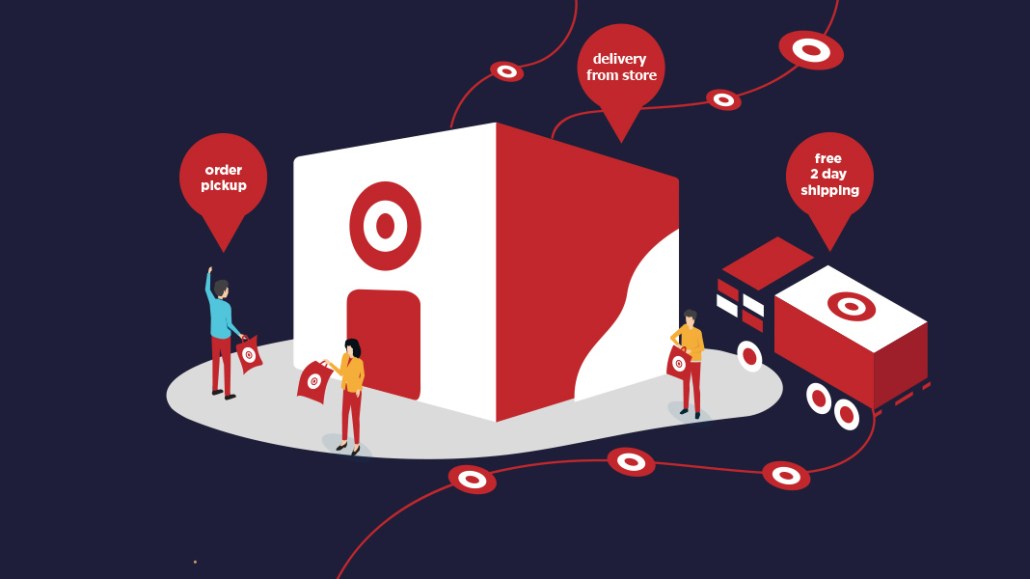Save 50% on a 3-month Digiday+ membership. Ends Dec 5.

Target is positioning itself as the anti-Amazon by using personalized, one-on-one support to improve its e-commerce deliveries.
Ahead of the holiday shopping season, the retailer is adding three upgrades to its e-commerce pickup and delivery offerings, two of which involve some form of human assistance. Target is growing the footprint of its subscription-based Shipt personalized shopper service to 46 states (up from 35). The retailer is also expanding curbside pickup to nearly 1,000 stores by the end of October. And it’s making a play for Amazon Prime customers by removing the $35 minimum spend for free two-day shipping from Nov. 1 until Dec. 22.
“We’ve got a strategy of stores as hubs as a key differentiator,” said Target rep Eddie Baeb. “The idea is that our stores are very close to where America lives.”
By using its more than 1,800 stores as focal points for its e-commerce business — 75 percent of the U.S. population lives within 10 miles of a Target store, according to the company — the retailer can use its store workers to connect with customers and nurture their connection to the brand. Other large retailers, including Walmart and Home Depot, have also used stores as pickup and delivery hubs — taking advantage of a physical store infrastructure that online-only retailers don’t have.
“They are leveraging their unique value proposition by enabling associates to provide additional services,” said Adam Silverman, svp of marketing at Theatro, a Dallas-based software company that works with retailers on business apps for indoor mobile workforces. “Amazon can’t do that and retailers are increasingly doing it to differentiate.”
Target is investing in improving the e-commerce experience in line with an expected e-commerce sales bump this holiday season. According to eMarketer, U.S. 2018 holiday e-commerce sales are expected to reach $123 billion, up 16 percent year-over-year. Emarketer expects e-commerce to capture 12.5 percent of total U.S. holiday season sales, which it predicts will be $987 billion. Meanwhile, with 100 million Amazon Prime members, a growing proportion of shoppers will already be online; Target wants to be where its customers are and set itself apart with with added services.
To pull off personalized deliveries from stores, Target is investing in technology. Through Shipt, the personalized shopper service and tech platform that the retailer reportedly acquired for $550 million last December, customers create a profile on the Shipt app outlining their preferences, and make purchases through it (the retailer’s inventory is integrated into the Shipt app). Once the order is placed, Shipt shoppers, who are independent contractors, review customer information saved to the app to personalize the order, and chat with customers to learn more about the customer’s needs. For example, a Shipt shopper could ask a customer how soft an avocado they would like, along with other attributes specific to their orders. The more purchases the customer makes, the smarter the platform gets.
Ad position: web_incontent_pos1
With data from Shipt and Target’s other pickup and delivery services, the retailer can better anticipate customer behavior, said Jonathan Smalley, CEO of Yaguara, a data analytics company that works with retailers. Shipt is also available for other retailers to use, including, for example, local New York grocery retailers like Fairway and Morton Williams.
“They’re seeing what’s being ordered on a daily basis, so they can see what customers are looking for an in what areas — that’s really powerful,” said Smalley. “They can start predicting what people are wanting in different areas, and have the right number of ‘shoppers’ available at busy times of the year.”
The curbside pickup option also uses technology to ensure timeliness. An in-house app on mobile devices used by employees uses geofencing to apprise employees when a customer has arrived to pick up an order. By deploying a Target employee to deliver the items to a customer’s car, it reduces wait times and also offers an additional help point if the customer needs more advice (Target also offers customers the ability to walk into stores to pick up orders as well).
“The customer is interfacing with someone who cares about their order and their experience as a customer,” Smalley said. “Amazon seems so impersonal; Target is smart to focus on that.”
As Target adds services, ensuring the integration of all of the delivery “pieces” into a single tech platform will ensure it can keep up with customer expectations, Smalley added. With the expansion of Shipt, curbside pickup, along with in-store pickup, same-day delivery from stores in selected urban areas, and Target Restock (Target’s answer to Amazon Prime Pantry), Target is offering as many options as possible to compete with Amazon. But pulling away loyal Amazon Prime members won’t be easy.
Ad position: web_incontent_pos2
“The challenge for both Target and Walmart in holiday seasons and in general is the growing number of Amazon Prime shoppers,” said Griffin Carlborg, senior specialist on large-format retail at Gartner L2. “What this does offer is a very interesting value proposition for customers that aren’t already Prime.”
More in Marketing

Ulta, Best Buy and Adidas dominate AI holiday shopping mentions
The brands that are seeing the biggest boost from this shift in consumer behavior are some of the biggest retailers.

U.K. retailer Boots leads brand efforts to invest in ad creative’s data layer
For media dollars to make an impact, brands need ad creative that actually hits. More CMOs are investing in pre- and post-flight measurement.

‘AI is permeating everything we do’: How Guitar Center developed 2 AI tools this year
This summer, the company launched a chatbot called Rig Advisor to help customers find the right instruments and products.
Ad position: web_bfu
